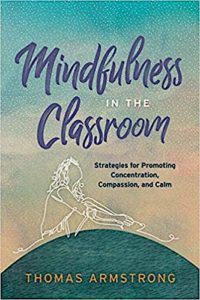Why Mindfulness Belongs in the Classroom
Mindfulness in the Classroom: Strategies for Promoting Concentration, Compassion, and Calm
By Thomas Armstrong
(ASCD, 2019 – Learn more)

Throughout the course of an average day, you have taken more than 17,000 breaths. Thousands of times when your lungs filled with and then expelled air. How many did you pay attention to? How many did you take with intention? If you’re like me, I am guessing not that many.

Mindfulness, as defined by this book, is “the intentional focus of one’s attention on the present moment in a nonjudgmental way” (2). He points out pitfalls that can be avoided in order to better support mindfulness efforts.
Armstrong advocates that teachers and administrators develop their own personal practice before introducing mindfulness to students. I agree that our personal buy-in is necessary for success.
My students know about my strong yoga and emerging meditation practice and so that is why they ask me if I can teach these topics to them. However, I don’t feel qualified to lead mindfulness yet. After reading this book, I am certainly more convinced that my school should be incorporating it into our program of studies.
Relating teacher stress to student outcomes
In addition to the research cited about teacher stress, Armstrong offers “that in a study of 121 teachers at elementary schools in a midwestern school district, the teachers who reported the highest stress levels and lowest levels of coping also had the worst student outcomes, such as lower math scores and more disruptive behaviors (Herman, Hickmon-Rosa, & Reinke, 2017)” (47). He acknowledges that while the research available is limited and evolving, based on what we can see so far, the potential benefits shouldn’t be ignored.
As educators, we are always focusing on finding avenues to improve academic performance. But we also know that we can’t ignore social-emotional learning. It seems that mindfulness can have a positive effect in all areas of student growth and development.
Mindfulness for all ages
The text includes examples for how mindfulness can be adapted for all age groups in all content areas. Armstrong also offers suggestions for how mindfulness can be seamlessly incorporated without taking away from instructional time.
I often begin class with independent reading as a way for my students to transition from their previous class (which could be physical education or a science lab). I have recently noticed that this strategy is not as effective as it used to be, and I am wondering if a few minutes of mindfulness would give my students a chance to refocus.
Armstrong offers resources like apps (Calm and Headspace) that are easy to access and use. I had both downloaded on my phone and this year started using Calm with some of my classes. The result is that my students began requesting mindfulness sessions.
Armstrong also advocates for a whole-school approach in order for mindfulness to be a sustainable practice. As teachers, we are responsible for our class environment, but we cannot shift school climate alone. Many of us are familiar with the impact a negative school culture can have, as outlined in the book Mindful Happiness by Anthony Quintiliani (2015):
“When a school is stress-prone, social-emotional stability is harmed, students do not learn well, and teachers and administrators may move into avoidance behaviors to protect themselves from the highly negative psychological and physical effects of chronic stress. Not many people smile or laugh as norms in such systems. More people are absent due to illness and fatigue, and parents and taxpayers are dissatisfied with outcomes versus costs” (97).
If mindfulness can improve even some of the above, then I’d say it’s a worthy endeavor. Armstrong includes a variety of options for implementation from multiple schools, showing us that those with the will can find a mindful way. He offers key strategies to increase the probability that your classroom or school efforts are successful.
This book is not a mindfulness program. When you reach the final page, you will not receive a certificate. However, what Thomas Armstrong does in Mindfulness in the Classroom is make a strong, research-based case for why mindfulness is essential for our students (and ourselves).
Armstrong delves into neuroscience in order to illustrate how mindfulness can reduce stress. The question isn’t whether or not mindfulness should become a core component in schools, but rather, what has taken us so long to realize it.
Nicole Warchol has been teaching middle school for more than a decade. She is a former NCTE Lead Ambassador and current Executive Board member for the New Jersey Council of Teachers of English. She is an Aquarius and so from birth she was destined to contain multitudes. Nicole is also a Ravenclaw who on occasion writes poetry and does yoga with puppies. She tweets from @MsNWarchol.





























